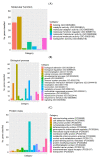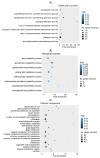Maternal Heat Stress Alters Expression of Genes Associated with Nutrient Transport Activity and Metabolism in Female Placentae from Mid-Gestating Pigs
- PMID: 33923747
- PMCID: PMC8073098
- DOI: 10.3390/ijms22084147
Maternal Heat Stress Alters Expression of Genes Associated with Nutrient Transport Activity and Metabolism in Female Placentae from Mid-Gestating Pigs
Abstract
Placental insufficiency is a known consequence of maternal heat stress during gestation in farm animals. The molecular regulation of placentae during the stress response is little known in pigs. This study aims to identify differential gene expression in pig placentae caused by maternal heat exposure during early to mid-gestation. RNA sequencing (RNA-seq) was performed on female placental samples from pregnant pigs exposed to thermoneutral control (CON; constant 20 °C; n = 5) or cyclic heat stress (HS; cyclic 28 to 33 °C; n = 5) conditions between d40 and d60 of gestation. On d60 of gestation, placental efficiency (fetal/placental weight) was decreased (p = 0.023) by maternal HS. A total of 169 genes were differentially expressed (FDR ≤ 0.1) between CON and HS placentae of female fetuses, of which 35 genes were upregulated and 134 genes were downregulated by maternal HS. The current data revealed transport activity (FDR = 0.027), glycoprotein biosynthetic process (FDR = 0.044), and carbohydrate metabolic process (FDR = 0.049) among the terms enriched by the downregulated genes (HS vs. CON). In addition, solute carrier (SLC)-mediated transmembrane transport (FDR = 0.008) and glycosaminoglycan biosynthesis (FDR = 0.027), which modulates placental stroma synthesis, were identified among the pathways enriched by the downregulated genes. These findings provide evidence that heat-stress induced placental inefficiency may be underpinned by altered expression of genes associated with placental nutrient transport capacity and metabolism. A further understanding of the molecular mechanism contributes to the identification of placental gene signatures of summer infertility in pigs.
Keywords: RNA-seq; gestation; heat stress; pigs; placenta; placental insufficiency; transport activity.
Conflict of interest statement
The authors declare no conflict of interest.
Figures




Similar articles
-
Controlled elevated temperatures during early-mid gestation cause placental insufficiency and implications for fetal growth in pregnant pigs.Sci Rep. 2020 Nov 26;10(1):20677. doi: 10.1038/s41598-020-77647-1. Sci Rep. 2020. PMID: 33244103 Free PMC article.
-
The identification of differentially expressed genes between extremes of placental efficiency in maternal line gilts on day 95 of gestation.BMC Genomics. 2019 Mar 29;20(1):254. doi: 10.1186/s12864-019-5626-0. BMC Genomics. 2019. PMID: 30925895 Free PMC article.
-
Heat stress affects fetal brain and intestinal function associated with the alterations of placental barrier in late pregnant mouse.Ecotoxicol Environ Saf. 2021 Dec 20;227:112916. doi: 10.1016/j.ecoenv.2021.112916. Epub 2021 Oct 23. Ecotoxicol Environ Saf. 2021. PMID: 34695613
-
Placental accommodations for transport and metabolism during intra-uterine crowding in pigs.J Anim Sci Biotechnol. 2014 Dec 15;5(1):55. doi: 10.1186/2049-1891-5-55. eCollection 2014. J Anim Sci Biotechnol. 2014. PMID: 25937925 Free PMC article. Review.
-
Proline metabolism in the conceptus: implications for fetal growth and development.Amino Acids. 2008 Nov;35(4):691-702. doi: 10.1007/s00726-008-0052-7. Epub 2008 Mar 11. Amino Acids. 2008. PMID: 18330497 Review.
Cited by
-
Consequences of maternal heat stress at different stages of embryonic and fetal development on dairy cows' progeny.Anim Front. 2021 Dec 17;11(6):48-56. doi: 10.1093/af/vfab059. eCollection 2021 Dec. Anim Front. 2021. PMID: 34934529 Free PMC article. No abstract available.
-
Heat Stress Modulates a Placental Immune Response Associated With Alterations in the Development of the Fetal Intestine and Its Innate Immune System in Late Pregnant Mouse.Front Physiol. 2022 Apr 4;13:841149. doi: 10.3389/fphys.2022.841149. eCollection 2022. Front Physiol. 2022. PMID: 35444558 Free PMC article.
-
Gestational heat stress alters skeletal muscle gene expression profiles and vascularity in fetal pigs in a sexually dimorphic manner.J Anim Sci Biotechnol. 2022 Jul 15;13(1):76. doi: 10.1186/s40104-022-00730-2. J Anim Sci Biotechnol. 2022. PMID: 35836286 Free PMC article.
-
Heat Stress Impairs Maternal Endometrial Integrity and Results in Embryo Implantation Failure by Regulating Transport-Related Gene Expression in Tongcheng Pigs.Biomolecules. 2022 Mar 2;12(3):388. doi: 10.3390/biom12030388. Biomolecules. 2022. PMID: 35327580 Free PMC article.
-
Impact of ambient heat exposure on pregnancy outcomes in low- and middle-income countries: A systematic review.Womens Health (Lond). 2024 Jan-Dec;20:17455057241291271. doi: 10.1177/17455057241291271. Womens Health (Lond). 2024. PMID: 39500870 Free PMC article.
References
-
- Bell A., Wilkening R., Meschia G. Some aspects of placental function in chronically heat-stressed ewes. J. Dev. Physiol. 1987;9:17–29. - PubMed
-
- Bell A. Prenatal programming of postnatal productivity and health of livestock: A brief review. Aust. J. Exp. Agric. 2006;46:725–732. doi: 10.1071/EA06006. - DOI
-
- Liu F., Ford E.M., Morrison R.S., Brewster C.J., Henman D.J., Smits R.J., Zhao W., Cottrell J.J., Leury B.J., Dunshea F.R. The Greater Proportion of Born-Light Progeny from Sows Mated in Summer Contributes to Increased Carcass Fatness Observed in Spring. Animals. 2020;10:2080. doi: 10.3390/ani10112080. - DOI - PMC - PubMed
MeSH terms
Substances
Grants and funding
LinkOut - more resources
Full Text Sources
Other Literature Sources
Molecular Biology Databases
Research Materials

